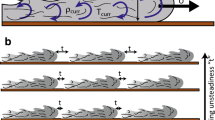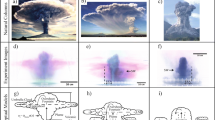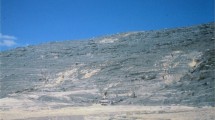Abstract
Stratified flow theory is applied to pyroclatic surges in an effort to gain insight into transport dynamics during explosive eruptions. Particle transport is assumed to be by turbulent suspension, and calculations contained herein show that this is likely for many cases including the 18 May 1980 blast at mount St. Helens. The discussion centers on the Rouse number (Pn), which represents a ratio of particle settling velocity to scale of turbulence; the Brunt-Väisälä frequency (N), which is the maximum possible frequency of internal waves; the Froude number (Fr), representing the ratio of inertial forces to gravitational forces; and the Richardson number (Ri), a ratio of buoyant restoring forces to turbulent mixing forces. The velocity or flow power dependence of bed-form wavelength in surge deposits is related to a velocity dependence of wavelength of internal waves in the turbulent surge. This produces a decrease in dune wavelength with increasing distance from vent. Migration direction of bed forms is related toFr as it is defined for a continuously stratified flow. Proximal to distal facies variations in surge deposits reflect increasingPn andRi as the flows move away from their sources. This produces the progression from sandwave to massive to planar facies with increasing distance from vent. Where the long axis of topography is at low angles to the flow direction, massive facies in topographic lows may from concurrently with sandwave facies on highs, due to the higher particle concentration in the lows. Where long axis of topography is at high angles to flow direction, denser lower parts of the surge may be dammed or “blocked”. Blocked material tends to form massive flows that may move down slope independent of the overriding surge. A model incorporating turbulent transport, stratified flow, and time evolution of pyroclastic surges is proposed for deposits which have been attributed to both pyroclastic flow and pyroclastic surge transport by various workers. During the initial high energy (waxing) phase of the eruptive event,Pn is sufficiently low that only coarse, but poorly sorted, material is deposited to form relatively coarse bottom layers. As the event wanes, remaining finer material is deposited through a thin bed load to produce overlying bedded and cross-bedded veneer deposits. Throughout most of the event, blocking occurs to produce relatively thick and massive deposits in valley bottoms.
Similar content being viewed by others
References
Bagnold RA (1956) Flow of cohesionless grains in fluids. Phil Trans R Soc London Ser A 255:235–297
Bird RB, Stewart WE, Lightfoot EN (1960) Transport phenomena. John Wiley and Sons New York, pp 160, 190–194
Campbell CS, Brennen CE (1985) Computer simulation of granular shear flows. J Fluid Mech 151:167–188
Crowe BM, Fisher RV (1973) Sedimentary structures in basesurge deposits with special reference to cross-bedding, Ubehebe Craters, Death Valley, California. Geol Soc Am Bull 84:663–682
Delvigne GAL (1986) Model for vertical diffusion in stratified flows. J Hydraulics Div: ASCE 112:1069–1086
Dingman SL (1984) Fluvial hydrology. WH Freeman and Co. New York, pp 105, 166–173
Druitt TH, Bacon CR (1986) Lithic breccia and ignimbrite erupted during the collapse of Crater Lake caldera, Oregon. J Volcanol Geotherm Res 29:1–32
Fisher RV (1979) Models for pyroclastic surges and pyroclastic flows. J Volcanol Geotherm Res 6:305–318
Fisher RV (1983) Flow transformations in sediment gravity flows. Geology 11:273–274
Fisher RV (1986) Systems of transport and deposition within pyroclastic surges: Evidence from Mount St. Helens, Washington. EOS Trans Am Geophys Union 67:1246
Fisher RV, Heiken G (1982) Mount Pelee, Martinique: May 8 and 20, 1902 pyroclastic flows and surges. J Volvanol Geotherm Res 13:339–371
Fisher RV, Schmincke H-U (1984) Pyroclastic rocks. Springer Berlin Heidelberg New York Tokyo, pp 247–257
Fisher RV, Waters AC (1970) Base surge bed forms in maar volcanoes. Am J Sci 268:157–180
Fisher RV, Glicken HX, Hoblitt RP (1987) May 18, 1980 Mount St. Helens deposits in South Coldwater Creek, Washington. J Geophys Res (in press)
Ghosh JK, Mazumder BS, Saha MR, Sengupta S (1986) Depositon of sand by suspension currents: Experimental and theoretical studies. J Sed Pet 56:57–66
Hoblitt RP, Miller DC (1984) Comment on “Mount St. Helens 1980 and Mount Pelee 1902 - Flow or surge?” Geology 12:692–693
Hoblitt RP, Miller DC, Vallance JE (1981) Origin and stratigraphy of the deposits produced by the May 18 directed blast. In: Lipman PW, Mullineaux DR (eds) The 1980 eruptions of Mount St. Helens, Washington, USGS Prof Pap 1250:401–419
Jobson HE, Sayre WW (1970) Vertical transfer in open channel flow. J Hydraulics Div: ASCE 96:703–724
Karl HA, Cacchione DA, Carlson PR (1986) Internal-wave currents as a mechanism to account for large sand waves in Navarinsky Canyon head, Bering Sea. J Sed Pet 56:706–714
Kennedy JF (1963) The mechanics of dunes and antidunes in erodible-bed channels. J Fluid Mech 30:741–773
Kieffer SW (1981) Fluid dynamics of the May 18 blast at Mount St. Helens. In: Lipman PW, Mullineaux DR (eds) The 1980 eruptions of Mount St. Helens, Washington, USGS Prof Pap 1250:379–400
Kieffer SW, Sturtevant B (1986) Erosional furrows formed during the lateral blast at Mount St. Helens, May 18, 1980: Indicators of longitudinal vortices in the boundary layer. Abstr Intl Volcanol Cong, New Zealand, p 53
Liepmann HW, Roshko A (1957) Elements of gas dynamics. John Wiley and Sons, Inc. New York, pp 338–340
Lin J-T, Pao Y-H (1979) Wakes in stratified fluids. Ann Rev Fluid Mech 11:317–338
Middleton GV, Southard JB (1978) Mechanics of sediment movement. Soc Econ Paleontol Mineral Short Course 3, Eastern Section, pp 6.37–41
Moore JG (1967) Base surge in recent volcanic eruptions. Bull Volcanol 30:337–363
Richards K (1982) Rivers, form and process in alluvial channels. Methuen & Co. Ltd. London, p 87
Savage SB (1984) The mechanics of rapid granular flows. Adv Applied Mech 24:289–366
Schlichting H (1979) Boundary-layer theory, 7th edition. McGraw-Hill Book Co. New York, pp 512–513, 715–723
Schmincke H-U, Fisher RV, Waters AC (1973) Antidune and chute and pool structures in the base surge deposits of the Laacher See area, Germany. Sedimentology 20:553–574
Sheppard PA (1956) Airflow over mountains. Qu J R Met Soc 82:528–529
Snyder WH, Thompson RS, Eskridge RE, Lawson RE, Castro IP, Lee JT, Hunt JCR, Ogawa Y (1985) The structure of strongly stratified flow over hilts: dividing-streamline concept. J Fluid Mech 152:249–288
Sparks RSJ (1976) Grain size variations in ignimbrites and implications for the transport of pyroclastic flows. Sedimentology 23:147–188
Sparks RSJ (1978) Gas release rates from pyroclastic flows: An assessment of the role of fluidisation in their emplacement. Bull Volcanol 41:1–9
Sparks RSJ, Walker GPL (1973) The ground surge deposit -A third type of pyroclastic rock. Nature, Phys Sci 241:62–64
Sparks RSJ, Wilson L, Hulme G (1978) Theoretical modeling of the generation, movement and emplacement of pyroclastic flows by column collapse. J Geophys Res 83:1727–1739
Thomas DG (1964) Periodic phenomena observed with spherical particles in horizontal pipes. Science 144:534–536
Valentine GA, Fisher RV (1986) Origin of layer 1 deposits in ignimbrites. Geology 14:146–148
Waitt RB Jr (1981) Devastating pyroclastic density flow and attendant air fall of May 18 - Stratigraphy and sedimentology of the deposits. In: Lipman PW, Mullineaux DR (eds) The 1980 eruptions of Mount St. Helens, Washington, USGS Prof Pap 1250:439–458
Waitt RB Jr (1984) Comments on “Mount St. Helens 1980 and Mount Pelee 1902 - Flow or surge?” Geology 12:693
Walker GPL (1983) Ignimbrite types and ignimbrite problems. J Volcanol Geotherm Res 17:65–88
Walker GPL (1984) Characteristics of dune-bedded pyroclastic surge bedsets. J Volvanol Geotherm Res 20:281–296
Walker GPL, McBroome LA (1983) Mount St. Helens 1980 and Mount Pelee 1902 - Flow or surge? Geology 11:571–574
Walker GPL, McBroome LA (1984) Reply to comments on “Mount St. Helens 1980 and Mount Pelee 1902 - Flow or surge?” Geology 12:693–695
Walker GPL, Wilson CJN (1983) Lateral variations in the Taupo ignimbrite. J Volcanol Geotherm Res 18:117–133
Walker GPL, Self S, Froggatt PC (1981a) The ground layer of the Taupo ignimbrite: A striking example of sedimentation from a pyroclastic flow. J Volcanol Geotherm Res 10:1–11
Walker GPL, Wilson CJN, Froggatt PC (1981b) An ignimbrite veneer deposit: The trail-marker of a pyroclastic flow. J Volcanol Geotherm Res 9:409–421
Waters AC, Fisher RV (1971) Base surges and their deposits: Capelinhos and Taal volcanoes. J Geophys Res 76:5596–5614
Wilson CJN (1980) The role of fluidization in the emplacement of pyroclastic flows: An experimental approach. J Volcanol Geotherm Res 8:231–249
Wilson CJN (1984) The role of fluidization in the emplacement of pyroclastic flows 2: Experimental results and their interpretation. J Volcanol Geotherm Res 20:55–84
Wilson CJN (1985) The Taupo eruption, New Zealand II: The Taupo ignimbrite. Phil Trans R Soc London Ser A 314:229–310
Wilson CJN, Walker GPL (1982) Ignimbrite depositional facies: The anatomy of a pyroclastic flow. J Geol Soc London 139:581–592
Wohletz KH, Sheridan MF (1979) A model of pyroclastic surge. Geol Soc Am Sp Pap 180:177–194
Wohletz KH, McGetchin TR, Sandford MT II, Jones EM (1984) Hydrodynamic aspects of caldera-forming eruptions: Numerical models. J Geophys Res 89:8269–8286
Wright JV, Smith AL, Self S (1980) A working terminology of pyroclastic deposits. J Volcanol Geotherm Res 8:315–336
Yih C-S (1980) Stratified flows. Academic Press New York, pp 103–141
Author information
Authors and Affiliations
Rights and permissions
About this article
Cite this article
Valentine, G.A. Stratified flow in pyroclastic surges. Bull Volcanol 49, 616–630 (1987). https://doi.org/10.1007/BF01079967
Received:
Accepted:
Issue Date:
DOI: https://doi.org/10.1007/BF01079967




